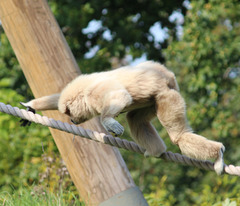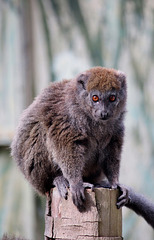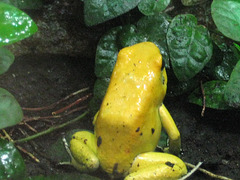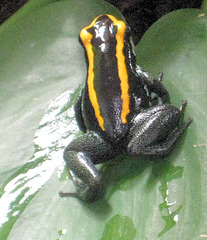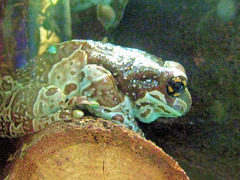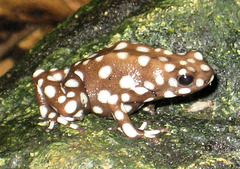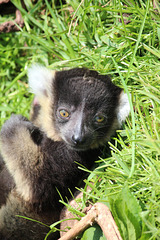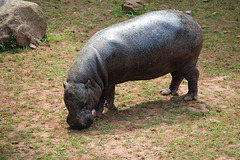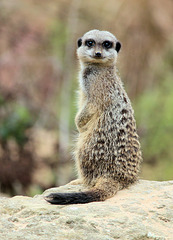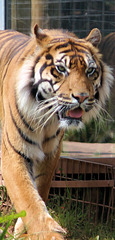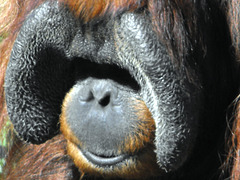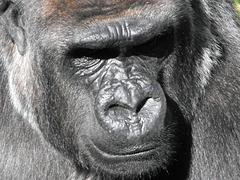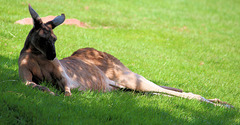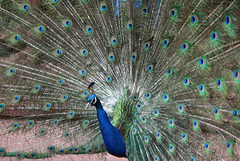D Bannister, Isle of Luing.'s photos
Oriental short clawed Otter.
| |
|
Home Range: Indonesia, southern China, southern India, the Philippines, and Southeast Asia.
Although these otters are not listed as endangered, they are seriously threatened by rapid habitat destruction, hunting, and pollution. Scientists consider them an indicator species—their population indicates the general health of their habitat and the health of other species in their habitat.
White handed Gibbon
| |
|
Gibbons are found in the rainforests of southeastern Asia.
Gibbons range in colour from light sandy blonde to dark brown. They
have thick, fluffy fur and slim bodies that are built for swinging from
trees. Adult gibbons average around 15 pounds. They have no tail.
Alaotran gentle lemur.
| |
|
This Critically Endangered lemur lives only in the papyrus and reed beds surrounding Madagascar’s largest lake - Lac Alaotra.
Golden poison arrow frog
| |
|
These frogs are often considered innocuous due to their small size and bright colours, but wild frogs are lethally toxic, and may be the most poisonous of any living animal.
Golfodulcean poison frog
| |
|
Endemic to the wet forests and lowlands of the Golfo Dulce region in the south-western part of Costa Rica.
Mission golden-eyed tree frog
| |
|
This frog lives high in the canopy of South America’s humid tropical rainforests. These species breed in tree cavities and may never come down to the ground. Because of their tree-dwelling lifestyle, they are rarely seen but have characteristic loud calls. They often live in vegetation which grows over slow-moving water.
Marañón poison frog
| |
|
This species is currently known with certainty only from a single location in the vicinity of the town of Santa Rosa at the foothills of the Cordillera del Cóndor (Cajamarca Department), north-eastern Peru, at around 1,000m asl.
Hamadryas Baboon
| |
|
Range: Found in Africa (Ethiopia and Somalia), Saudi Arabia and Yemen.
Threats: The hamadryas baboon is listed as ‘vermin’ by the African Convention on the Conservation of Nature and Natural Resources. The Hamadryas has been exterminated in Egypt and reduced in numbers in other areas. Locally the baboon is at risk from an increase in populated areas, overgrazing, development and deforestation which has lead to conflicts with people.
Black and White Ruffed Lemur
| |
|
Pygmy Hippopotamus
| |
|
Habitats: Less aquatic than the large hippo their preferred habitat is thick undergrowth near rivers or streams or the border zone between rainforests and swamps. Hippos will rest for most of the day in the shade and begin to feed in late afternoon. When foraging in tropical forests they make deep paths similar to tunnels within the dense brush, when foraging in water they form canal like pathways.
Meerkat
| |
|
The meerkat or suricate, Suricata suricatta, is a small mammal belonging to the mongoose family. Meerkats live in all parts of the Kalahari Desert in Botswana, in much of the Namib Desert in Namibia and southwestern Angola, and in South Africa. A group of meerkats is called a "mob", "gang" or "clan". A meerkat clan often contains about 20 meerkats, but some super-families have 50 or more members. In captivity, meerkats have an average life span of 12–14 years, and about half this in the wild.
Andean Bear.
| |
|
Found: South America..Habitats: The spectacled bear has a reputation for being adaptable, as it is found in a wide variety of habitats and altitudes throughout its range, including cloud forests, high altitude grasslands, dry forest and scrub desert, at altitudes of 250 to the snowline.
Sumatran Tiger.
| |
|
Information: The Sumatran Tiger lives on the equator at an average temperature of 26 Celsius all the time.
Lion
| |
|
Sumatran Orangutan.
| |
|
Orangutans are unique in many ways. They are the only Great Ape in Southeast Asia, and the only Great Ape (other than humans) found outside Africa. They are the only 'red' ape, and the only strictly arboreal ape, meaning that they spend their lives in the forest canopy, even building nests in the trees in which to sleep. The other Great Apes (chimpanzees, bonobos and gorillas) do climb and build nests in the trees, but tend to spend their lives on the ground.
Lowland Gorrilla
| |
|
Location
Central African Republic, Equatorial Guinea, Gabon, Congo, Cabinda (enclave of Angola) and the extreme western tip of Zaire.
Red Kangaroo.
| |
|
Habitat: This kangaroo occurs in arid and semi-arid habitats, in areas with 500 to 800 mm annual rainfall. It may be found in scrubland, grassland, woodland and desert, tending to prefer open grassy plains with scattered trees for shade and shelter.
Peacock.
Jump to top
- ipernity © 2007-2024
- Help & Contact
|
Club news
|
About ipernity
|
History |
ipernity Club & Prices |
Guide of good conduct
Donate | Group guidelines | Privacy policy | Terms of use | Statutes | In memoria -
Facebook
Twitter


